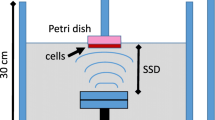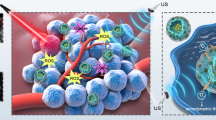Abstract
Ultrasound (US) has been applied in clinical practice for its non-invasive and high selectivity. However, it is difficult to achieve a satisfactory anti-tumor effect with US alone. Meanwhile, the use of US therapy alone can exacerbate tumor hypoxia. In this study, we prepared hypoxia-activated 6-diazo-5-oxo-L-norleucine (DON) prodrug nanoparticles (HDON-NPs) to improve US therapeutic effects. In an H22 murine liver cancer model, US therapy selectively disrupted tumor blood vessels, leading to increased tumor hypoxia and a 1.67-fold increase in the expression of nitroreductase (NTR). The combination therapy of US and HDON-NPs demonstrated a synergistic effect, resulting in a tumor suppression rate (TSR) of 90.2% ± 6.4%, which was 5.93-fold higher than that of US therapy alone. The combined treatment selectively blocked the glutamine metabolism of the tumor cells while simultaneously activating the T cells in the tumor microenvironment, thereby exerting a robust anti-tumor effect.

Similar content being viewed by others
References
Zhang, N. S.; Wang, J.; Foiret, J.; Dai, Z. F.; Ferrara, K. W. Synergies between therapeutic ultrasound, gene therapy and immunotherapy in cancer treatment. Adv. Drug Del. Rev. 2021, 178, 113906.
Zhang, D.; Wang, X. Y.; Lin, J. J.; Xiong, Y. Q.; Lu, H. X.; Huang, J. Y.; Lou, X. Multi-frequency therapeutic ultrasound: A review. Ultrason. Sonochem. 2023, 100, 106608.
Deprez, J.; Lajoinie, G.; Engelen, Y.; De Smedt, S. C.; Lentacker, I. Opening doors with ultrasound and microbubbles: Beating biological barriers to promote drug delivery. Adv. Drug Del. Rev. 2021, 172, 9–36.
Yue, W. W.; Chen, L.; Yu, L. D.; Zhou, B. G.; Yin, H. H.; Ren, W. W.; Liu, C.; Guo, L. H.; Zhang, Y. F.; Sun, L. P. et al. Checkpoint blockade and nanosonosensitizeriaugmented noninvasive sonodynamic therapy combination reduces tumour growth and metastases in mice. Nat. Commun. 2019, 10, 2025.
Wu, R. R.; Yao, Z. C.; Chen, Z. X.; Ge, X. G.; Su, L. C.; Wang, S. H.; Wu, Y.; Song, J. B. Ultoasnund-activated NIR chemiluminescence for deep tissue and tumor foci imaging. Anal. Chem. 2023, 95, 11219–11226.
Zhang, Z.; Li, B.; Xie, L. S.; Sang, W.; Tian, H.; Li, J.; Wang, G. H.; Dai, Y. L. Metali phenolic networkienabled lactic acid consumption reverses immunosuppressive tumor microenvironment for sonodynamic therapy. ACS Nano 2021, 15, 16934–16945.
Chaussy, C.; Thüroff, S.; Rebillard, X.; Gelet, A. Tcdinolggy insight: Highiintensity focused ultrasound for urologic cancers. Nat. Clin. Pract. Urol. 2005, 2, 191–198.
Guzman, M. L.; Rossi, R. M.; Karnischky, L.; Li, X. J.; Peterson, D. R.; Howard, D. S.; Jordan, C. T. The sesquiterpene lactone parthenolide induces apoptosis of human acute myelogenous leukemia stem and progenitor cells. Blood 2005, 105, 4163–4169.
Miller, D. L.; Smith, N. B.; Bailey, M. R.; Czarnota, G. J.; Hynynen, K.; Makin, I. R. S. Overview of therapeutic ultrasound applications and safety considerations. J. Ultrasound Med. 2012, 31, 623–634.
Rapoport, N. Y.; Kennedy, A. M.; Shea, J. E.; Scaife, C. L.; Nam, K. H. Controlled and targeted tumor chemotherapy by ultrasoundi activated nanoemulsions/microbubbles. J. Controlled Release 2009, 138, 268–276.
Chen, Y. H.; Du, M.; Yuan, Z.; Chen, Z. Y.; Yan, F. Spatiotemporal control of engineered bacteria to express interferon-y by focused ultrasound for tumor immunotherapy. Nat. Commun. 2022, 13, 4468.
Yumita, N.; Umemura, S. Sonodynamic therapy with photofrin II on AH130 solid tumor. Cancer Chemother. Pharmacol. 2003, 51, 174–178.
Wang, D. W.; Lin, L.; Li, T.; Meng, M.; Hao, K.; Guo, Z. P.; Chen, J.; Tian, H. Y.; Chen, X. S. Etching bulk covalent organic frameworks into nanoparticles of uniform and controllable size by the molecular exchange etching method for sonodynamic and immune combination antitumor therapy. Adv. Mater. 2022, 34, 2205924.
Hunt, S. J.; Gade, T.; Soulen, M. C.; Pickup, S.; Sehgal, C. M. Antivascular ultrasound therapy. J. Ultrasound Med. 2015, 34, 275–287.
Wood, A. K. W.; Ansaloni, S.; Ziemer, L. S.; Lee, W. M. F.; Feldman, M. D.; Sehgal, C. M. The antivascular action of physiotherapy ultrasound on murine tumors. Ultrasound Med. Biol. 2005, 31, 1403–1410.
Li, C.; Yang, X. Q.; An, J.; Cheng, K.; Hou, X. L.; Zhang, X. S.; Hu, Y. G.; Liu, B.; Zhao, Y. D. Red blood cell membrane-enveloped O2 selfisupplementing biomimetic nanoparticles for tumor imagingi guided enhanced sonodynamic therapy. Teranoostics 2020, 10, 867–879.
Vaupel, P.; Mayer, A.; Höckel, M. Tumor hypoxia and malignant progression. Methods Enzymol. 2004, 381, 335–354.
Cosse, J. P.; Michiels, C. Tumour hypoxia affects the responsiveness of cancer cells to chemotherapy and promotes cancer progression. Anticancer Agents Med. Chem. 2008, 8, 790–797.
Bai, R. X.; Li, Y. N.; Jian, L. Y.; Yang, Y. H.; Zhao, L.; Wei, M. J. The hypoxia-driven crosstalk between tumor and tumor-associated macrophages: Mechanisms and clinical treatment strategies. Mol. Cancer 2022, 21, 177.
Sharma, A.; Arambula, J. F.; Koo, S.; Kumar, R.; Singh, H.; Sessler, J. L.; Kim, J. S. Hypoxia- targeted drug delivery. Chem. Soc. Rev. 2019, 48, 771–813.
Xu, X. X.; Chen, S. Y.; Yi, N. B.; Li, X.; Chen, S. L.; Lei, Z. X.; Cheng, D. B.; Sun, T. L. Research progress on tumor hypoxia-associative nanomedicine. J. Controlled Release 2022, 350, 829–840.
Chen, Y.; Hu, L. Q. Design of anticancer prodrugs for reductive activation. Med. Res. Rev. 2008, 29, 29–64.
Singleton, D. C.; Macann, A.; Wilson, W. R. Therapeutic targeting of the hypoxic tumour microenvironment. Nat. Rev. Clin. Oncol. 2021, 18, 751–772.
Sun, J. L.; Liu, Z. L.; Yao, H. C.; Zhang, H. L.; Zheng, M. F.; Shen, N.; Cheng, J. J.; Tang, Z. H.; Chen, X. S. Azide-masked resiquimod activated by hypoxia for selective tumor therapy. Adv. Mater. 2023, 35, 2207733.
Hay, M. P.; Gamage, S. A.; Kovacs, M. S.; Pruijn, F. B.; Anderson, R. F.; Patterson, A. V.; Wilson, W. R.; Brown, J. M.; Denny, W. A. Structure-activity relationships of 1,2,4-benzotriazine 1,4-dioxides as hypoxia-selective analogues of tirapazamine. J. Med. Chem. 2003, 46, 169–182.
Li, G.; Zhang, J. B.; Zhang, S. X.; Teng, L. S.; Sun, F. Y. Multifunctional nanoadjuvant-driven microenvironment modulation for enhanced photothermal immunotherapy in breast cancer. J. Controlled Release 2023, 362, 309–324.
Zheng, M. F.; Xu, H.; Huang, Y.; Sun, J. L.; Zhang, H. L.; Lv, Z.; Liu, Z. L.; Tang, Z. H.; Chen, X. S. Hypoxia- activated glutamine antagonist prodrug combined with combretastatin A4 nanoparticles for tumor-selective metabolic blockade. J. Controlled Release 2024, 365, 480–490.
Wise, D. R.; Ward, P. S.; Shay, J. E. S.; Cross, J. R.; Gruber, J. J.; Sachdeva, U. M.; Platt, J. M.; DeMatteo, R. G.; Simon, M. C.; Thompson, C. B. Hypoxia promotes isocitrate dehydrogenase-dependent carboxylation of α-ketoglutarate to citrate to support cell growth and viability. Proc. Natl. Acad. Sci. USA 2011, 108, 19611–19616.
Metallo, C. M.; Gameiro, P. A.; Bell, E. L.; Mattaini, K. R.; Yang, J. J.; Hiller, K.; Jewell, C. M.; Johnson, Z. R.; Irvine, D. J.; Guarente, L. et al. Reductive glutamine metabolism by IDH1 mediates lipogenesis under hypoxia. Nature 2012, 481, 380–384.
Vander Heiden, M. G.; Cantley, L. C.; Thompson, C. B. Understanding the Warburg effect: The metabolic requirements of cell proliferation. Science 2009, 324, 1029–1033.
Yoo, H. C.; Yu, Y. C.; Sung, Y.; Han, J. M. Glutamine reliance in cell metabolism. Exp. Mol. Med. 2020, 52, 1496–1516.
Vander Heiden, M. G. Targeting cancer metabolism: A therapeutic window opens. Nat. Rev. Drug Discov. 2011, 10, 671–684.
Xiong, J.; Wang, N.; Zhong, H. J.; Cui, B. W.; Cheng, S.; Sun, R.; Chen, J. Y.; Xu, P. P.; Cai, G.; Wang, L. et al. SLC1A1 mediated glutamine addiction and contributed to natural killer T-cell lymphoma progression with immunotherapeutic potential. eBioMedicine 2021, 72, 103614.
Stine, Z. E.; Schug, Z. T.; Salvino, J. M.; Dang, C. V. Targeting cancer metabolism in the era of precision oncology. Nat. Rev. Drug Discov. 2022, 21, 141–162.
Reinfeld, B. I.; Madden, M. Z.; Wolf, M. M.; Chytil, A.; Bader, J. E.; Patterson, A. R.; Sugiura, A.; Cohen, A. S.; Ali, A.; Do, B. T. et al. Cell- programmed nutrient partitioning in the tumour microenvironment. Nature 2021, 593, 282–288.
Wang, Y. Y.; Bai, C. S.; Ruan, Y. X.; Liu, M.; Chu, Q. Y.; Qiu, L.; Yang, C. Z.; Li, B. H. Coordinative metabolism of glutamine carbon and nitrogen in proliferating cancer cells under hypoxia. Nat. Commun. 2019, 10, 201.
Jin, Z. J. About the evaluation of drug combination. Acta Pharmacol. Sin. 2004, 25, 146–147.
Ma, Z. Y.; Zhang, Y. F.; Dai, X. X.; Zhang, W. Y.; Foda, M. F.; Zhang, J.; Zhao, Y. L.; Han, H. Y. Selective thrombosis of tumor for enhanced hypoxia-activated prodrug therapy. Adv. Mater. 2021, 33, 2104504.
Acknowledgements
This work was financially supported by the Ministry of Science and Technology of China (No. 2022YFE0110200), the Natural Science Foundation of Jilin Province (No. 20230101037JC), and the National Natural Science Foundation of China (Nos. 52203198 and 52025035).
Author information
Authors and Affiliations
Corresponding authors
Electronic Supplementary Material
12274_2024_6534_MOESM1_ESM.pdf
Synergistic enhancement of ultrasound therapy for tumors using hypoxia-activated 6-diazo-5-oxo-L-norleucine (DON) prodrug nanoparticles
Rights and permissions
About this article
Cite this article
Zheng, M., Liu, Z., Xu, H. et al. Synergistic enhancement of ultrasound therapy for tumors using hypoxia-activated 6-diazo-5-oxo-L-norleucine (DON) prodrug nanoparticles. Nano Res. (2024). https://doi.org/10.1007/s12274-024-6534-4
Received:
Revised:
Accepted:
Published:
DOI: https://doi.org/10.1007/s12274-024-6534-4




